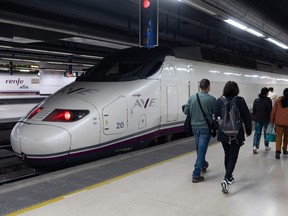We need better, faster, cleaner travel, especially in the Quebec City-Windsor corridor, which 18 million people call home.
Published Jan 15, 2024 • Last updated 6 hours ago • 3 minute read
 Passengers walk past an AVE high-speed train at Barcelona-Sants railway station prior to departing to Lyon on a test trip along a new international rail line between Spain and France, in Barcelona on Feb. 13, 2023. Could similar trains cover the Quebec City-Windsor corridor? Photo by JOSEP LAGO /AFP via Getty Images
Passengers walk past an AVE high-speed train at Barcelona-Sants railway station prior to departing to Lyon on a test trip along a new international rail line between Spain and France, in Barcelona on Feb. 13, 2023. Could similar trains cover the Quebec City-Windsor corridor? Photo by JOSEP LAGO /AFP via Getty Images
Imagine walking into Ottawa Station, grabbing breakfast, and hopping aboard your train at 10 a.m. You settle down, open your laptop and finish up a couple of reports for work. Two hours later, you step off the train in Toronto’s Union Station just in time for lunch with an important client.
After, you take a few calls and clear your inbox. At 5 p.m., you hop on your train back to Ottawa, have dinner, and have a quick nap after a long day. By 7 p.m., you’re in a cab on your way home to your family for the night.
Advertisement 2
This advertisement has not loaded yet, but your article continues below.
THIS CONTENT IS RESERVED FOR SUBSCRIBERS ONLY
Subscribe now to read the latest news in your city and across Canada.
Exclusive articles from Elizabeth Payne, David Pugliese, Andrew Duffy, Bruce Deachman and others. Plus, food reviews and event listings in the weekly newsletter, Ottawa, Out of Office.Unlimited online access to Ottawa Citizen and 15 news sites with one account.Ottawa Citizen ePaper, an electronic replica of the print edition to view on any device, share and comment on.Daily puzzles, including the New York Times Crossword.Support local journalism.
SUBSCRIBE TO UNLOCK MORE ARTICLES
Subscribe now to read the latest news in your city and across Canada.
Exclusive articles from Elizabeth Payne, David Pugliese, Andrew Duffy, Bruce Deachman and others. Plus, food reviews and event listings in the weekly newsletter, Ottawa, Out of Office.Unlimited online access to Ottawa Citizen and 15 news sites with one account.Ottawa Citizen ePaper, an electronic replica of the print edition to view on any device, share and comment on.Daily puzzles, including the New York Times Crossword.Support local journalism.
REGISTER TO UNLOCK MORE ARTICLES
Create an account or sign in to continue with your reading experience.
Access articles from across Canada with one account.Share your thoughts and join the conversation in the comments.Enjoy additional articles per month.Get email updates from your favourite authors.
Article content
Article content
This would be the future if Canada were to build high-speed rail in the Quebec City-Windsor corridor.
With the growing threat of a climate crisis, Canadians deserve frequent, reliable, high-speed and non-polluting rail service between our biggest population centres, just as other G7 countries have.
Electrified rail service is far more energy-efficient than airplane or automobile travel, and with more Canadians incentivized to ride the rails, there would be fewer planes in the sky and cars on the road.
Unfortunately, high-speed rail does not appear to be a priority for the current federal government. The Liberals are currently awaiting proposals from three contenders to build a high-frequency network between Toronto and Quebec City, but not a high-speed one.
While having more frequent trains would be a marked improvement over today’s service, it would be a lost opportunity to build a new intercity rail system without being able to offer high-speed travel.
What’s more, the high-frequency rail plan would leave out southwestern Ontario, skipping over major economic centres including Hamilton, Kitchener-Waterloo, London and Windsor.
Advertisement 3
This advertisement has not loaded yet, but your article continues below.
Article content
Leaving these communities out of the plan would be very unfortunate, especially considering the very forgiving agricultural landscapes west of Toronto.
As it stands, if you were to take an Ottawa-Toronto journey today, you would either have to fly, drive or take VIA Rail.
Flying would be time-consuming with ground transportation to and from suburban airports, security line-ups, and boarding waiting time.
If you were to drive, you’d lose hours of productive time and energy behind the wheel.
If you were to take VIA Rail, you’d enjoy the convenience of downtown-to-downtown transit, but your scheduled 4.5-hour ride could be riddled with delays thanks to the private freight operators who own and manage most tracks between Windsor and Quebec City.
There is a reason Air Canada offers 12 daily round-trip flights between Ottawa and Toronto-Pearson: the train just isn’t good enough for many travellers.
Canadians deserve better, faster, cleaner and more convenient connectivity between communities, especially in this corridor, which is home to 18 million people.
Advertisement 4
This advertisement has not loaded yet, but your article continues below.
Article content
Students in London should be able to visit their families in Ottawa without it being a major expedition. Public servants in Quebec City should be able to make reasonable day trips to Montreal.
Rail projects can be expensive and time-consuming to build, but to take this step into the future, we must act now. The best time to build high-speed rail was yesterday. The second-best time is today.
If Canada wants to show it’s taking serious action on climate change, it would be great to start by getting people off the highways, out of the skies and onto high-speed trains.
David Landry is a sustainable transportation advocate pursuing a Bachelor of Arts and Science at McMaster University. Email: [email protected]
Recommended from Editorial

Timbilla: Now is exactly the time for Canada to build high-speed rail

Hill: Even Russia has high-speed train travel. Why don’t we?
Article content
>>> Read full article>>>
Copyright for syndicated content belongs to the linked Source : OttawaCitizen – https://ottawacitizen.com/opinion/landry-to-fight-climate-change-move-people-from-highways-and-planes-to-high-speed-trains































